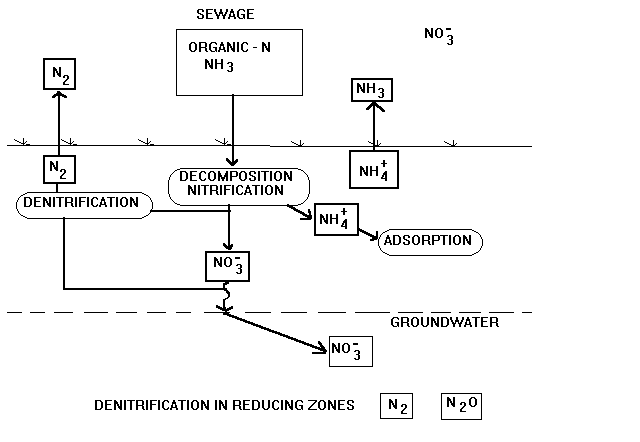Interested in Education/Training?
Get Education/Training articles, news and videos right in your inbox! Sign up now.
Education/Training + Get AlertsThe majority of the nitrogen present in raw sewage is from urea and fecal material, although small amounts are found in some household cleaners. Nitrogen is an essential chemical element and nutrient for all life forms. It constitutes 78 percent of the atmosphere by volume and is present in surface water and groundwater as ammonia, nitrite, nitrate and organic nitrogen. Total nitrogen is the measure of the complete nitrogen content in wastewater including nitrate (NO3-), nitrite (NO2-), ammonia (NH3), ammonium (NH4+), and organic nitrogen (expressed as mg/L of N); all these forms of nitrogen, as well as nitrogen gas (N2), can be converted from one form to another biochemically and are components of the nitrogen cycle.
- NH3 nonionized form of reduced nitrogen
- NH4+ ionized form of reduced nitrogen usable by plants
- NO3- stable oxidized form of nitrogen usable by plants and usually not degraded in groundwater; nitrifying bacteria can convert NO2- to NO3- in the nitrogen cycle
- NO2- unstable oxidized form of nitrogen
- Total Kjeldahl Nitrogen (TKN) is the measure of the total concentration of organic nitrogen, ammonia and ammonium nitrogen
- Organic nitrogen is the nitrogen bound in plant and animal matter, primarily amino acids and proteins; the amount of organic nitrogen can be obtained by separately measuring the NH3 and subtracting that value from the TKN
- N2 nitrogen gas

Nitrogen concerns
Contamination of groundwater with nitrates is a problem in many parts of the U.S. and has been widely documented. Potential health concerns where contaminated groundwater is used as a drinking water source include methemoglobinemia, carcinogenesis and birth defects. Ammonia in surface water can be toxic to fish and nitrate can cause growth of toxic algae and other problems in marine/ocean environments. Advanced pretreatment may be required in some situations to minimize the release of nitrogen to the environment that can affect water quality and public health.
Nitrogen in septic systems
As nitrogen moves through the treatment system, it changes from ammonia to nitrate. While it is possible for nitrate to change into nitrogen gas in some systems, conventional systems do not facilitate this change, so the nitrate may move into groundwater. To remove nitrogen in a septic system, two process are needed:
- Nitrification is a two-step autotrophic process (nitrifiers use CO2 instead of organic carbon as their carbon source for cell synthesis) for the conversion of NH4+ to NO3-. Nitrification systems must thus be designed to allow sufficient detention time within the system for nitrifying bacteria to grow. Temperature, pH and chemical inhibitors can also play a key role.
- Denitrification is a biological process that uses NO3- as the electron acceptor (hence nitrification must precede denitrification) instead of O2 to oxidize organic matter (heterotrophic denitrification) or inorganic matter such as sulfur or hydrogen (autotrophic denitrification) under anoxic conditions. In the process, NO3- is reduced to N2 gas.
About the author
Sara Heger, Ph.D., is an engineer, researcher and instructor in the Onsite Sewage Treatment Program in the Water Resources Center at the University of Minnesota. She presents at many local and national training events regarding the design, installation, and management of septic systems and related research. Heger is education chair of the Minnesota Onsite Wastewater Association and the National Onsite Wastewater Recycling Association, and she serves on the NSF International Committee on Wastewater Treatment Systems. Ask Heger questions about septic system maintenance and operation by sending an email to kim.peterson@colepublishing.com.
This article is part of the series: An Installer's Guide to Wastewater Characteristics
- The Installer’s Guide to BOD5
- An Installer’s Guide to Total Suspended Solids
- An Installer’s Guide to COD
- An Installer’s Guide to FOG
- An Installer’s Guide to Phosphorus
- An Installer’s Guide to Wastewater Pathogens
- An Installer’s Guide to Nitrogen






